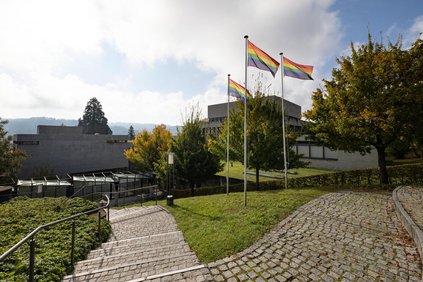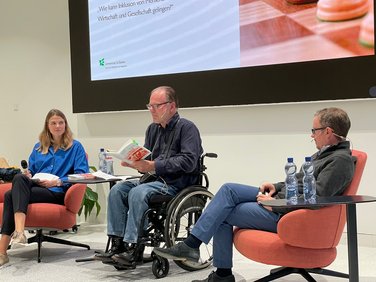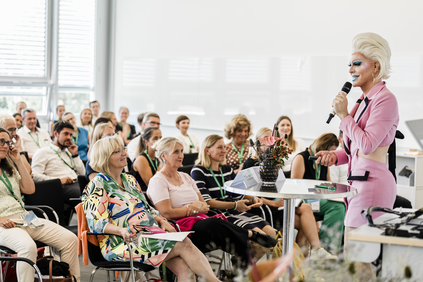Opinions - 11.06.2021 - 00:00
Concerns about the appreciation of care work still remain
After the women's strike on June 14, 2019, there were calls for the largely female care work in this country to be recognized as valuable work. But after one and a half years of life in times of Corona, the current situation gives little cause for euphoria. An opinion piece by Christa Binswanger.

11 June 2021. We are in 2021. This year, we are celebrating 50 years of women’s suffrage in this country, i.e. the fact that women were acknowledged to be fully-fledged citizens – although this acknowledgement came very late in comparison with the rest of Europe. And a look back at the great women’s strike on 14 June 2019 revives the experienced solidarity which found expression in this strike. Among other things, there was a call for care work, which was predominantly done by women, to be recognised and appreciated as valuable work at last in this country. But after one and a half years of living together in times of corona, the current situation gives little cause for euphoria: the calls remain largely unheard. The impact of the pandemic is hitting the group of women harder than the group of men; precarisation in the service sector, in the low-wage sector and in the caring professions has increased rather than decreased. All in all, the wage level, which ought to be raised in the care sector as a matter of urgency, has remained unchanged and low.
In today’s article, I first want to have a look at history: why is it that western societies in general and Switzerland in particular baulk at recognising care work, which is understood to be feminine, and paid work, which is understood to be male, as being of equal value? And how is the persistence of care work as a great inequality engine – as the economist Mascha Madörin calls it – reflected in the new divorce law, for instance?
History of the differentiation of gender roles
A look at the history of the Enlightenment makes it clear: the differentiation of the gender roles in the small family went hand in hand with the establishment of bourgeois society. Until the 18th century, marriages were primarily one thing: an economic community which – outside nobility, which was organised in its own way – determined rights and obligations for the spouses in the context of an extended family, including servants. Ideas of specifically female characteristics – such as motherliness and empathy – only emerged in the wake of the bourgeois enlightenment; in the history of ideas, they were concomitant with classicism and romanticism. Only at that time did the idea come into being that children are not small adults and require special motherly care work. The historian Karin Hauser classified this development as a bourgeois wife’s submission to and material dependence on the requirements of an enlightened bourgeois husband. One consequence of this is the fact, for example, that women qua gender were excluded from university studies until the late 19th century. The so-called “one breadwinner” model increasingly replaced the previous home community. The small bourgeois family experienced its heyday after the Second World War until approximately the 1980s. The model of bourgeois marriage displays its powerful impact in western societies to this day – even though it is showing more and more cracks at present.
Care work in families with children
What is the situation of care work in families with children today? Since people who are gainfully employed are particularly dependent on care work provided by others, today’s heterosexual marriages in Switzerland are characterised by an unequal distribution of paid gainful employment and unpaid care work. In today’s classic small families, mothers take on two thirds of unpaid care work and fathers one third on average. This may mean an increase in paternal commitment, but at the same time it also means that fathers do 80-100% of gainful employment, which enables them to establish themselves on the labour market. At the same time, the vast majority of women work shorter times (30% on average) and are unable to gain either qualifications or promotion. To speak of mothers’ freedom of choice fails to take into account the institutional conditions in Switzerland: as the sociologist René Levy has demonstrated, the retraditionalisation of mothers after having their first child and their withdrawal from the labour market does not primarily satisfy their values and wishes, but is based, on the one hand, on lacking or too expensive care options and, on the other hand, on the conservative values in Switzerland with which young mothers are confronted. The majority of couples who before the birth of their first child assume that they would be committed to an egalitarian division of labour, revise this view after a year: their values are adapted in the direction of an unequal division of “female” unpaid care work and “male” gainful employment.
Revision of divorce law
Let us imagine that paid gainful employment and unpaid care work were rated as of equal value in society. If this idea had become part of the current revision of divorce law, the wife’s unpaid care work, which enabled the husband to establish himself professionally during the years of their marriage, would enter the equation in a divorce situation. In current discourses, it is primarily emphasised that a 45-year-old mother would “simply have to return to work” after the divorce. The fact that she has done unpaid care work and will probably take on the large part of their unpaid work after the divorce, too, is a completely blind spot in such statements. The work she has done without payment is not recognised as work.
And so the appreciation of care work still remains an urgent concern of gender equality policy in June 2021.
Prof. Dr. Christa Binswanger is Permanent Lecturer for Gender and Diversity at the University of St.Gallen.
Foto: Adobe Stock / Oksana Kuzmina
More articles from the same category
This could also be of interest to you
Discover our special topics
















